Robert E. Howard (Scifi Wright): This story contains more plot twists than other Conan yarns, and no one is whom he seems. On the one hand, it is perhaps the most crowded hence enjoyable of his stories, containing elements of everything a Conan story should have, and more. On the other, Conan seems not so much like Conan as elsewhere, and he is largely swept along by events. One thing missing from the text is any depth.
other Conan yarns, and no one is whom he seems. On the one hand, it is perhaps the most crowded hence enjoyable of his stories, containing elements of everything a Conan story should have, and more. On the other, Conan seems not so much like Conan as elsewhere, and he is largely swept along by events. One thing missing from the text is any depth.
 Disney (Arkhaven Comics): Something that was rattling around in my bean over the weekend was the tone of Disney’s reply to Scarlet Johansson’s lawsuit. The tone reflected genuine aggrievement. As if matters had been settled, an agreement had been reached and then Johansson went ahead and sued anyway. Everyone in Hollywood was going on about how shocked everyone else felt by this lawsuit because stars as big as Johansson don’t have to do this.
Disney (Arkhaven Comics): Something that was rattling around in my bean over the weekend was the tone of Disney’s reply to Scarlet Johansson’s lawsuit. The tone reflected genuine aggrievement. As if matters had been settled, an agreement had been reached and then Johansson went ahead and sued anyway. Everyone in Hollywood was going on about how shocked everyone else felt by this lawsuit because stars as big as Johansson don’t have to do this.
Conventions (Pulpfest): PulpFest is not only lauded for its excellent programming but also its very substantial dealers’ room. Beginning on Thursday, August 19, the DoubleTree by Hilton Hotel Pittsburgh – Cranberry will be home to thousands of collectible pulp magazines and digests, vintage paperbacks, first edition hardcovers and series books, original art, B-movies and serials, collectible comic books, and much more.
Authors (DMR Books): This anniversary—like that of Gene Day—crept upon me. I knew it was Klarkash-Ton’s deathdate, but I forgot the numerical significance. I have a major post to do tomorrow and this milestone just slipped my mind. Time for some off-the-cuff commentary.
RPG (Chaosium): When the world of roleplaying games was still waiting to be born, you and your closest friends conjured up the Society for Creation Anachronism (SCA) from the realms of your collective imagination. Bump, bump, bump down the stairs, indeed. Shortly thereafter Steve and his wife Luise joined the fledging Chaosium as it spread its draconic wings in the mid-1970s with White Bear & Red Moon, and a little known RPG called RuneQuest, born on the 4th of July in 1976.
be born, you and your closest friends conjured up the Society for Creation Anachronism (SCA) from the realms of your collective imagination. Bump, bump, bump down the stairs, indeed. Shortly thereafter Steve and his wife Luise joined the fledging Chaosium as it spread its draconic wings in the mid-1970s with White Bear & Red Moon, and a little known RPG called RuneQuest, born on the 4th of July in 1976.
Gaming (Men of the West): Blizzard Entertainment is a video game company that was responsible for iconic franchises such as Warcraft, Starcraft, and Diablo. They have recently come under media fire due to the State of California performing a multi-year investigation into sexual misconduct within the company. I will make the case that their improper behavior is not what the media describes it as. Nor is the general discontent of their fans over the narrative direction of the game without merit.
Awards (Monster Hunter Nation): he Dragon Award nominees were announced this morning. Gun Runner, by me and John Brown, is up for best Mil SF. Ironically, I know almost every other author in that same category, and they’re awesome. Hell, I’ve Book Bombed two of them. 😀 I’ve known Marko since before either of us were writers. I think Christopher is one of the best young writers alive. I was just talking to Rick this morning before either of us realized we were nominated in the same category!
D&D (Walker’s Retreat): Over the weekend, Jeffro Johnson appeared on Geek Gab to talk about his discovery of how D&D is meant to be played. This came about because he sat down with the rules, read them for comprehension, and implemented them as-written to see how the machine of the game’s design actually worked in operation. No House Rules, no tinkering. Contrary to many, AD&D 1st Edition actually works as intended and as stated when you do so.
Publishing (DMR Books): If you ask sword-and-sorcery fans what their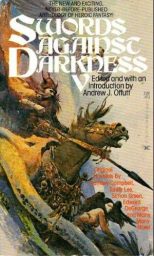 favorite anthology series is, the answer you’re most likely to get is Swords Against Darkness. Coming at the end of the S&S boom in the late ‘70s, in only three short years editor Andrew J. Offutt produced five volumes of the series. The contents hold up well today, which is no surprise, considering talents like Poul Anderson, Tanith Lee, Manly Wade Wellman, and Ramsey Campbell contributed original fiction to Swords A.D. The question remains, why didn’t the series go on longer?
favorite anthology series is, the answer you’re most likely to get is Swords Against Darkness. Coming at the end of the S&S boom in the late ‘70s, in only three short years editor Andrew J. Offutt produced five volumes of the series. The contents hold up well today, which is no surprise, considering talents like Poul Anderson, Tanith Lee, Manly Wade Wellman, and Ramsey Campbell contributed original fiction to Swords A.D. The question remains, why didn’t the series go on longer?
Review (The Silver Key): I get asked for book reviews, with some amount of frequency. I don’t blame anyone for asking me, or asking others, to review their book. Now that I’m an author I empathize with that sentiment, quite deeply. All authors want and need readers, and reviewers. More than money, or at least on equal footing, writers crave readers who enjoy their work. They seek validation that their work is good, and connects with a reader on some emotional level. And most want others to write about their book.
Review (Yard Sale of the Mind): Combat Frame XSeed, by Brian Niemeier. This is fun book. Jumps right in with dramatic escapes, last-second rescues, and battles to the death, with moral questions about exactly how far one is justified to go in war. The story features a bunch of well-drawn characters who unfold and gain depth over time. And giant punchy mechs with swords and stuff!
Review (Porpor Books): ‘Planet Run’ first was published in 1967 in hardcover by Doubleday; this mass market paperback edition (143 pp.) was published by Berkley Books in July, 1968, and features a great cover illustration by Paul Lehr. ‘Run’ is set in the far future, when most habitable worlds within Federation space have been colonized and exploited. The one major exception is the planet of Corazon, which has been off-limits for decades.
hardcover by Doubleday; this mass market paperback edition (143 pp.) was published by Berkley Books in July, 1968, and features a great cover illustration by Paul Lehr. ‘Run’ is set in the far future, when most habitable worlds within Federation space have been colonized and exploited. The one major exception is the planet of Corazon, which has been off-limits for decades.
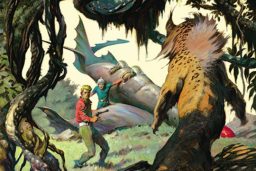 Edgar Rice Burroughs (Pulpfest): First published in the January 1942 issue of THE BLUE BOOK MAGAZINE, Edgar Rice Burroughs’ novella, “Beyond the Farthest Star,” concerns an American pilot who is about to die in a dogfight during the Second World War. Seconds from death on his home planet, he finds himself transported to the war-torn world of Poloda. Called Tangor, “from nowhere,” by the planet’s inhabitants, the pilot takes the side of the country of Unis in the war.
Edgar Rice Burroughs (Pulpfest): First published in the January 1942 issue of THE BLUE BOOK MAGAZINE, Edgar Rice Burroughs’ novella, “Beyond the Farthest Star,” concerns an American pilot who is about to die in a dogfight during the Second World War. Seconds from death on his home planet, he finds himself transported to the war-torn world of Poloda. Called Tangor, “from nowhere,” by the planet’s inhabitants, the pilot takes the side of the country of Unis in the war.
New (Dark Worlds Quarterly): Swords of Fire 2 in Trade paperback! In the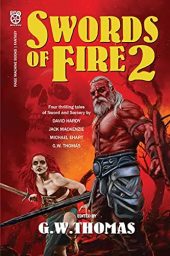 words of Charlton Heston, “You finally really did it!” Yup, eleven years later, a second volume in the Swords of Fire series. Once again, four storytellers present 15,000 word novellas of Swords and Sorcery in lands long forgotten or never were. And all wrapped up in a wonderful M. D. Jackson cover with four black & white illustrations.
words of Charlton Heston, “You finally really did it!” Yup, eleven years later, a second volume in the Swords of Fire series. Once again, four storytellers present 15,000 word novellas of Swords and Sorcery in lands long forgotten or never were. And all wrapped up in a wonderful M. D. Jackson cover with four black & white illustrations.
RPG (Pulp Net): I have posted on other role-playing games based on pulp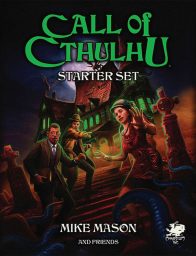 themes, usually pulp heroes, adventures, private eyes, etc. One area I have avoided was those based on the works of H.P. Lovecraft. While there are several now, the first and best-known is Call of Cthulhu, which I obtained shortly after its release in 1981 and played several times in the ’80s. Published by Chaosium, it’s based on their Basic Role-Playing (BRP) system, like their other games. Designed by Sandy Petersen, Chaosium has had its ups and downs over the years.
themes, usually pulp heroes, adventures, private eyes, etc. One area I have avoided was those based on the works of H.P. Lovecraft. While there are several now, the first and best-known is Call of Cthulhu, which I obtained shortly after its release in 1981 and played several times in the ’80s. Published by Chaosium, it’s based on their Basic Role-Playing (BRP) system, like their other games. Designed by Sandy Petersen, Chaosium has had its ups and downs over the years.
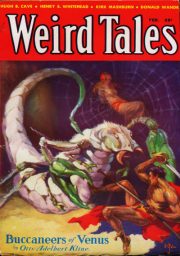 Weird Tales (M Porcius): Let’s take a gander at the February 1933 issue of Farnsworth Wright’s Weird Tales. Now, we’ve already read one story from its pages, Donald Wandrei’s “The Fire Vampires,” but the issue also includes stories from two men we venerate, H. P. Lovecraft and Clark Ashton Smith, and two men whose work we (sometimes) tolerate, Hugh B. Cave and August Derleth, so let’s check them out.
Weird Tales (M Porcius): Let’s take a gander at the February 1933 issue of Farnsworth Wright’s Weird Tales. Now, we’ve already read one story from its pages, Donald Wandrei’s “The Fire Vampires,” but the issue also includes stories from two men we venerate, H. P. Lovecraft and Clark Ashton Smith, and two men whose work we (sometimes) tolerate, Hugh B. Cave and August Derleth, so let’s check them out.
Games (Geek Native): The works of H.P. Lovecraft have inspired almost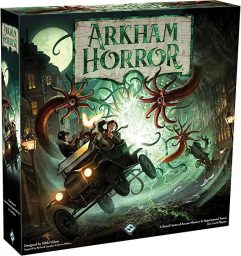 countless movies, television episodes, web-comics, and much weirder forms of merchandising like Cthulhu snacks, bedspreads, and plush Elder Gods. A descent into insanity is the perfect topic for any friendly game night. Seances aren’t as big as they used to be, but games inspired by Lovecraftian fiction are pretty damn popular. If you’re done with Monopoly and Uno, cue your darkest dungeon-based soundtrack for a look into the abyss.
countless movies, television episodes, web-comics, and much weirder forms of merchandising like Cthulhu snacks, bedspreads, and plush Elder Gods. A descent into insanity is the perfect topic for any friendly game night. Seances aren’t as big as they used to be, but games inspired by Lovecraftian fiction are pretty damn popular. If you’re done with Monopoly and Uno, cue your darkest dungeon-based soundtrack for a look into the abyss.
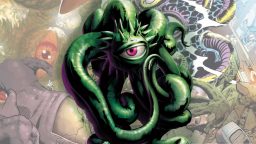 Comic Books (Games Radar): Classic Doctor Strange villain Shuma-Gorath may have appeared in What If…? – and that could bring some interesting comic book connections to the screen. Fans of classic Marvel video games got a bit of a thrill in the first episode of Disney Plus’ MCU animated streaming show What If…? thanks to the appearance of a villain who, though unnamed, looked a heck of a lot like cult-favorite Doctor Strange villain Shuma-Gorath.
Comic Books (Games Radar): Classic Doctor Strange villain Shuma-Gorath may have appeared in What If…? – and that could bring some interesting comic book connections to the screen. Fans of classic Marvel video games got a bit of a thrill in the first episode of Disney Plus’ MCU animated streaming show What If…? thanks to the appearance of a villain who, though unnamed, looked a heck of a lot like cult-favorite Doctor Strange villain Shuma-Gorath.
D&D (Goodman Games): when I wasn’t watching animatronic monsters and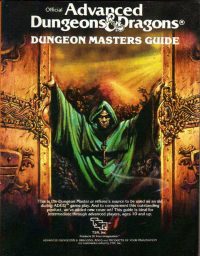 corn syrup blood effects on screen, I was pouring over the AD&D Dungeon Masters Guide with all the fervent intent of an accountant cramming for the CPA exam. Dungeons & Dragons’ impact on me as an 11 year old was as thoroughly profound as its impact on gaming or pop culture in general; it changed everything. The very nature of an RPG shifts things from a narrative abstract to the realm of the personal – all of a sudden fantasy worlds and adventures weren’t the subject of passive entertainment and idle musing, they were a world that my friends and I could now actively experience first hand.
corn syrup blood effects on screen, I was pouring over the AD&D Dungeon Masters Guide with all the fervent intent of an accountant cramming for the CPA exam. Dungeons & Dragons’ impact on me as an 11 year old was as thoroughly profound as its impact on gaming or pop culture in general; it changed everything. The very nature of an RPG shifts things from a narrative abstract to the realm of the personal – all of a sudden fantasy worlds and adventures weren’t the subject of passive entertainment and idle musing, they were a world that my friends and I could now actively experience first hand.
 Fiction (Killer Covers of the Week): British journalist-turned-author Frederick Forsyth was just 33 years old when his first novel, a political thriller titled The Day of the Jackal, originally saw print. The book was released in the United Kingdom on June 7, 1971, by Hutchinson & Company, and on August 6, 1971—50 years ago today—in the United States, by Viking Press.
Fiction (Killer Covers of the Week): British journalist-turned-author Frederick Forsyth was just 33 years old when his first novel, a political thriller titled The Day of the Jackal, originally saw print. The book was released in the United Kingdom on June 7, 1971, by Hutchinson & Company, and on August 6, 1971—50 years ago today—in the United States, by Viking Press.
Firearms (Frontier Partisans): The South African historian and historical reenactor MC Heunis recently posted on social media a shot of himself with an antelope taken with a replica of a Dutch flintlock. He noted that the weapon would have been common among Boer frontiersmen in the period 1835-45. That got me to pondering upon the long reign of the flintlock on the frontiers of the world. By the period Heunis references, the somewhat more reliable and slightly faster percussion cap lock was on the scene — yet the flintlock persisted.
reenactor MC Heunis recently posted on social media a shot of himself with an antelope taken with a replica of a Dutch flintlock. He noted that the weapon would have been common among Boer frontiersmen in the period 1835-45. That got me to pondering upon the long reign of the flintlock on the frontiers of the world. By the period Heunis references, the somewhat more reliable and slightly faster percussion cap lock was on the scene — yet the flintlock persisted.
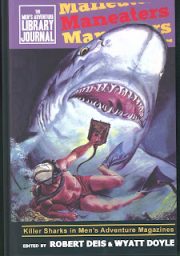 Fiction (Pulp Fiction Review): With apologies to Peter Benchley, just when you thought it was safe go back into the Mam’s pulp library comes “Maneaters.” This is a collection of sixteen over-the-top tales of deadly shark encounters as offered in various Men’s Adventure Magazines during the 1960s, to include two wonderful cover photo and illustrations galleries. In all, these stories exemplify the horror thrills associated with these deadly sea predators and each entry provides more than enough blood and guts gore to engender some truly colorful nightmares and keep one from ever venturing out into the sea ever again.
Fiction (Pulp Fiction Review): With apologies to Peter Benchley, just when you thought it was safe go back into the Mam’s pulp library comes “Maneaters.” This is a collection of sixteen over-the-top tales of deadly shark encounters as offered in various Men’s Adventure Magazines during the 1960s, to include two wonderful cover photo and illustrations galleries. In all, these stories exemplify the horror thrills associated with these deadly sea predators and each entry provides more than enough blood and guts gore to engender some truly colorful nightmares and keep one from ever venturing out into the sea ever again.
Tolkien (Sacnoth’s Scriptorium): I have recently heard that I may well be in error. According to French Tolkien linguist Damien Bador, and quoted from a recent email with his permission:
“There is one point where I need to mention that I believe you’re clearly mistaken. On several occasions, you take pains to stress that wolves only attack people in fairy tales, not in reality. As far as I’m aware, this is quite true for the American wolf, but not so much for the European (and Asian) one.”
Art (Goodman Games): he Robert E. Howard Art Chronology currently on Kickstarter tells the story of Howard’s fiction as it has been depicted and translated into visual art from the earliest pulp magazine covers to the present day, in a huge four volume hardback set collecting both the unforgettably iconic works of artists such as Margaret Brundage, Frank Frazetta, and Michael Whelan, as well as never-before-reprinted art and illustrations rescued from archival obscurity and preserved here for a new generation of fans.
Kickstarter tells the story of Howard’s fiction as it has been depicted and translated into visual art from the earliest pulp magazine covers to the present day, in a huge four volume hardback set collecting both the unforgettably iconic works of artists such as Margaret Brundage, Frank Frazetta, and Michael Whelan, as well as never-before-reprinted art and illustrations rescued from archival obscurity and preserved here for a new generation of fans.
 Fiction (Pulp Net): For those not up on things, Solar Pons is Derleth’s Sherlock Holmes pastiche, set in the 1920s and ’30s, which I’ve posted on previously. I realized that for most of these I hadn’t read them since I discovered Pons in college. While I finally recently obtained the rest that I previously had no access to, I hadn’t yet read them. So I am reading through the eight-volume set of Solar Pons stories by August Derleth from Belanger Books, as well as the seven-volume set of stories by Basil Cooper from PS Publications. And I will be alternating between the two.
Fiction (Pulp Net): For those not up on things, Solar Pons is Derleth’s Sherlock Holmes pastiche, set in the 1920s and ’30s, which I’ve posted on previously. I realized that for most of these I hadn’t read them since I discovered Pons in college. While I finally recently obtained the rest that I previously had no access to, I hadn’t yet read them. So I am reading through the eight-volume set of Solar Pons stories by August Derleth from Belanger Books, as well as the seven-volume set of stories by Basil Cooper from PS Publications. And I will be alternating between the two.
Please give us your valuable comment